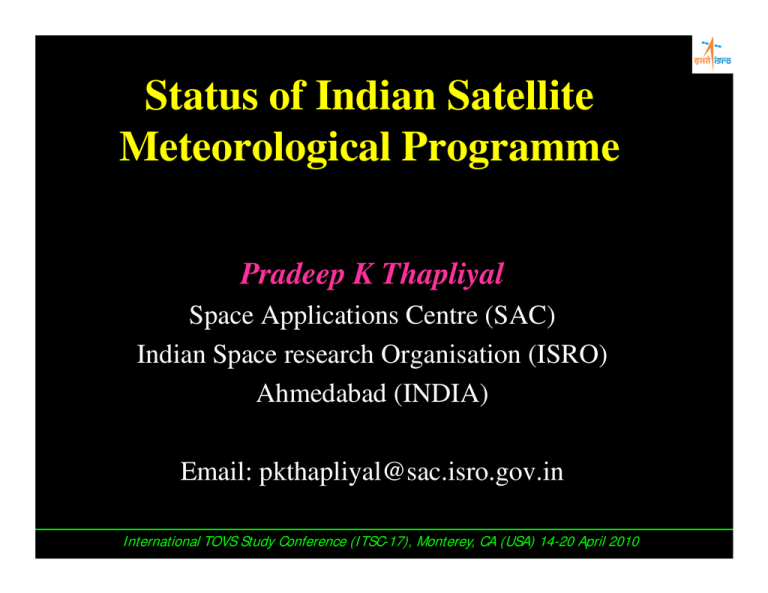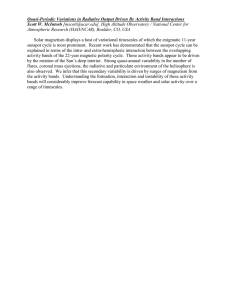Status of Indian Satellite Meteorological Programme Pradeep K Thapliyal
advertisement

Status of Indian Satellite Meteorological Programme Pradeep K Thapliyal Space Applications Centre (SAC) Indian Space research Organisation (ISRO) Ahmedabad (INDIA) Email: pkthapliyal@sac.isro.gov.in International TOVS Study Conference (ITSC-17), Monterey, CA (USA) 14-20 April 2010 Indian Meteorological Satellite Missions • Payload and Satellite: Design & Fabrication – Geostationary : Optical – Polar Orbiting: Thrust on Microwave ( Passive/Active) • Launch : – Polar : – Geostationary : Operational Operational • Signal and Data Processing , Retrievals, Validation • Data Archival and Dissemination – Meteorological & Oceanographic Satellite Data Archival Center (MOSDAC) PSLV • Calibration & Validation (CALVAL) • Applications with Users – Operational – R & D ( National Institutions and Academia) GSLV Indian Missions for Weather & Climate Studies : Current & Future Kalpana-1 2002 G E O INSATINSAT-3D (2010) VHRR, CCD VHRR CMV, OLR, UTH,Rain L E O INSAT-3A (2003) CMV, OLR, UTH, Rain, Aerosol OCEANSAT–1/2 (1999/2009) MSMR, OCM, Scatterometer ROSA (GPS) Vector Winds, Aerosol, T&h Profile 6-Ch VHRR 19-Ch Sounder SST, CMV, OLR, UTH, Rain, T-q Profile, O3 SARAL (2011) INSATINSAT-3D R GeoGeo-HR ( ~2012) 2012) Follow Follow--up (~2015 (~ 2015)) MEGHA-TROPIQUES MEGHA(2011) Altimeter SSH, Waves, Winds MW Imager, WV Sounder, ScaRaB ROSA SS Wind, TWV, Rainfall T, h Profile, Radiation Budget INSATINSAT-3A & Kalpana Kalpana--1 • • • • Location : INSAT 3A : 93.5ºE Kalpana-1 : 74ºE Payload : (i) VHRR & CCD camera in INSAT 3A (ii) VHRR in Kalpana-1 VHRR Bands (µm) – Visible – Water vapour – Thermal Infra Red Resolution (km) : 0.55 – 0.75 : 5.70 – 7.10 : 10.5 – 12.5 : 2 X 2 for Visible 8 X 8 for TIR and WV CCD Camera Bands (µm) – Visible – Near Infra Red – Short Wave Infra Red Resolution (km) : 0.62 – 0.68 : 0.77 – 0.86 : 1.55 – 1.69 : 1 X 1 for all bands KalpanaKalpana-1 Products (IMDPS) INSAT - 3D 6 Channel IMAGER • Spectral Bands (µm) Visible : 0.55 - 0.75 Short Wave IR : 1.55 - 1.70 Mid Wave IR : 3.80 – 4.00 Water Vapour : 6.50 - 7.10 Thermal IR – 1 : 10.30 - 11.30 Thermal IR – 2 : 11.50 - 12.50 • Resolution : 1 km for VIS, SWIR 4 km for MIR, TIR 8 km for WV 19 Channel SOUNDER • Spectral Bands (µm) Short Wave IR : Six bands Mid Wave IR : Five Bands Long Wave IR Bands : Seven Visible : One Band • Resolution (km) : 10 X 10 for all bands • No of simultaneous sounding per band : Four Oceansat -II • Instruments: – Scatterometer Ku band (13.515 GHz) – Ocean Colour Monitor (8 bands 0.4- 0.885 µm) – Radio Occultation ROSA • Launched - 23 September 2009 • Applications: – – – – – – Sea State Forecast: Waves, Circulation and MLD Monsoon and Cyclone Forecast Antarctic Sea Ice Fisheries and Primary productivity estimation Detection and monitoring of Phytoplankton blooms Sediment dynamics Megha Tropiques SAPHIR For studying water cycle and energy exchanges in the tropical belt Low inclination (20º) for • Six atmospheric layers upto 12 km height • 10 km Horizontal Resolution SCARAB • Outgoing fluxes at TOA frequent simultaneous • 40 km Horizontal Resolution observations of tropics • Water vapour • Clouds • 183 GHz WV Sounder MADRAS • Cloud condensed • Precipitation and cloud properties • 89 &157 GHz : ice particles in cloud tops water • 18 & 37 GHz: cloud liquid water and precipitation • Precipitation • evaporation • 23 GHz : Integrated water vapour ROSA • T & q profile Contributing to GPM and GEWEX SARALSARAL-AltiKa (ISRO(ISRO-CNES) AltiKa Mission: Global altimetry system for the precise and accurate observations of ocean topography, circulation and sea surface monitoring launch Date: 2011 AltiKa Payload : ¾ A Ka-band (35.75 GHz, BW 500 MHz) radar altimeter ¾ A dual-frequency MW radiometer (23.8 and 37 GHz), for tropospheric range correction ¾ DORIS: For achieving adequate orbitography performances ¾ LRA: For Orbitography and system calibration AltiKa/SARAL central objective : Ocean meso-scale variability: Sea state Monitoring & Now Casting Data assimilation: Sea state forecasting Coastal altimetry: Bathymetry, coastal upwelling, Circulations etc. Satellite Description : • • • • Sun-synchronous, polar orbiting inclination: 98.38 Deg. Altitude: ~800 km, Repeat cycle: 35 days Future Geostationary Satellites • INSAT 3D Repeat (~ 2012) • Follow-up of INSAT-3D (~2015) • Geo – HR ( ~2012) [name yet to be frozen] – Visible – 50 m – 3 Channel IR – 1.5 Km – Visible and SWIR Hyper-spectral – 500 m 50 – 60 channels in VIS 50 – 60 channels in SWIR - For general remote sensing, can also be used for meteorological purpose • Microwave Temperature Sounder (Definition stage)

